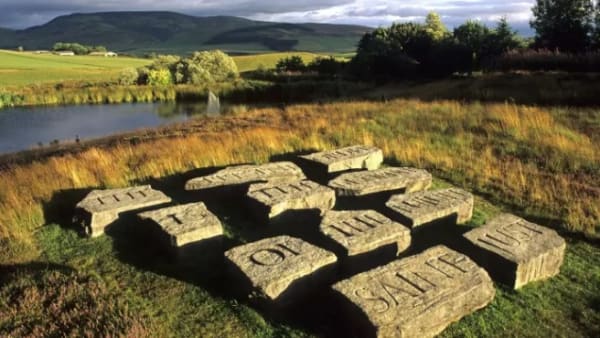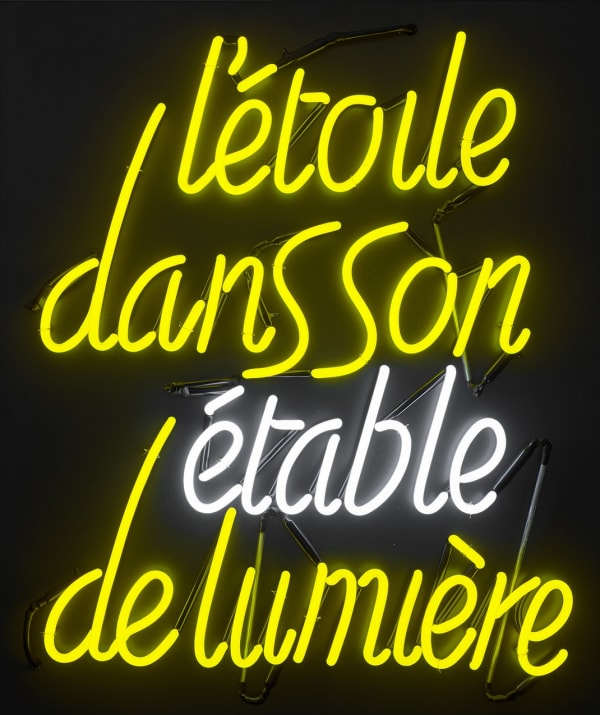The Sonnet is a Sewing-Machine for the Monostich is the largest ever presentation of Finlay's rarely seen neon works, which date back to the early seventies and run parallel to his better-known inscriptions on stone. In his essay to accompany the exhibition Stephen Bann has noted: 'There can be no doubt that neon poems were an integral part of Finlay's oeuvre, and embodied some of his earliest intuitions about extending his poetic ideas beyond the printed page, as objects in the world.'
The exhibition comprises two distinct bodies of work - in the upper gallery, a collection of neon works first exhibited in 1993 at the Crawford Arts Centre, St Andrews, Scotland and in the lower gallery neon works and wall texts relating to the French Revolution. The 'monostich' of the exhibition's title is a poem of one line, an uncommon form first widely used by the Russian poet Emmanual Lochac, who lived in France from 1894
Finlay's neon works in the upper gallery cast a reminder that words can also function as images, being composed as if in the artist's own hand. The brevity and verbal economy of the monostich compels and invites the viewer to impose their own interpretations on Finlay's work, which can often be understood on several levels - a riddle for the viewer to unravel. Finlay's simple, rural background is overlaid by his self-taught erudition - a voracious reader with an impressive personal library, Finlay discovered and took pleasure in a huge variety of historical figures, events and facts little known by others, and delighted in incorporating them in his work. The shortest of his neons, 'parheliacal marble' amply illustrates this, with his use of the unusual 'parheliacal' (the formal adjective derived from the Greek, describing sun dogs, the luminous spots in clouds caused by the sun's refraction through ice crystals). Juxtaposed with marble, the viewer is invited to imagine the effect as a marble statue shining in the Greek sun.
Poems that recur in other corners of Finlay's oeuvre also find themselves illuminated here: 'blue water's bark' proposes a kind of wordplay for deep water, or ocean-voyaging. Finlay intended the poem to reflect on the spelling of 'bark', its alternative literary spelling 'barque' (meaning boat) and lyrically, as the material that parallels the texture of rippled water. One's imagination is invited to see beyond the words to a blue-painted ship, the bark of a tree that became a ship, the blue sea.
A main theme running through Finlay's practice was the French Revolution, a key work of which was 'A View to the Temple', an installation of four guillotines exhibited in 1987 at Documenta 8, Kassel. The exhibition at Victoria Miro Gallery will include three seminal neons, 'Matisse Chez Duplay (unique in Finlay's neon works for its detail in opposition to the abbreviated form he uses elsewhere), 'Je Vous Salue Marat' and 'Ici on Danse'. 'Matisse Chez Duplay' describes Robespierre's room, which belonged to the humble cabinetmaker Duplay, in the words of Lamartine, in his 'History of The Girondists. 'Ici on Danse' celebrates the fall of the Bastille as described by Camille Desmoulins. 'Je Vous Salue Marat' is self-explanatory in its simplicity on one level, celebrating the life of the French Revolutionary Marat, but is also a play on the inscription 'Je Vous Salue Marie' in Notre Dame du Haut, the Chapel at Ronchamp in France.
The Sonnet as a Sewing-Machine for the Monostich is conceived by Pia Maria Simig. Neons in collaboration with Julie Farthing.
-

Ian Hamilton Finlay: Fragments is reviewed in Sculpture Magazine
May 12 2025'This much-deserved centenary celebration demonstrates the continued relevance of his questioning work.'Read More -

Ian Hamilton Finlay’s Republic is The Week in Art’s Work of the Week
May 6 2025For The Art Newspaper’s The Week in Art podcast, Ben Luke spoke to Stephen Bann about this sculptural work, currently on view at the gallery...Read More
-

Ian Hamilton Finlay’s son Alec Finlay on the centenary of his father's birth in The World of Interiors
April 23 2025'He experienced language as a Heraclitan and oracular medium. To him, the poem was an exemplary device that had a gift for revealing the metamorphoses words contain.'Read More -

Ian Hamilton Finlay’s Little Sparta featured in the Financial Times
April 17 2025'As a whole, Little Sparta is “like a cryptic crossword puzzle. It’s a place that allows you to think.”'Read More
-

The Observer reviews Ian Hamilton Finlay at the National Galleries of Scotland
March 23 2025★★★★ 'His is an art of distillation, juxtaposition, thrift and contemplation... Finlay understood as few other artists the emotional power of letters cutting into form, shape and colour.'Read More -

Exhibitions celebrating the centenary of Ian Hamilton Finlay feature in The Times Scotland
March 1 2025'...Finlay saw himself as a disruptor, someone who challenged the establishment and picked quarrels with it, whenever he felt its power was being misused.'Read More
-

A centenary display of works by Ian Hamilton Finlay at National Galleries of Scotland
February 24 2025On view at Modern Two from 8 March–26 May 2025, the display includes sculptures, prints and a room-size installation as well as extensive archival material....Read More -

Ian Hamilton Finlay features in Landscape and Imagination: From Gardens to Land Art at Compton Verney
March 2 2024The exhibition (21 March–16 June 2024) explores the beauty of nature, reimagined and reinterpreted through the hands of artists and landscape designers who throughout history...Read More
-

Marine: Ian Hamilton Finlay at City Art Centre, Edinburgh
May 22 2021This major exhibition (22 May–3 October 2021) focuses on the maritime theme in Finlay’s work. It was a central element of his art, and one...Read More -

Ian Hamilton Finlay is featured in the UCL exhibition Witnessing Terror: French Revolutionary Prints
January 6 2020The exhibition (14 January–12 June 2020) showcases UCL Art Museum’s unique holdings of prints related to the French Revolution and draws out the contemporary relevance...Read More
-

Ian Hamilton Finlay in Machines à Penser at Fondazione Prada, Venice
May 24 2018Curated by Dieter Roelstraete, the exhibition (26 May–25 November 2018) explores the correlation between conditions of exile, escape and retreat and physical or mental places...Read More -

An Ian Hamilton Finlay exhibition and talk are a focal point of this year’s Ilkley Literature Festival
August 1 2017The exhibition (30 September 2017), Ian Hamilton Finlay’s Visual Poetry, at Manor House, features sculptures and inscriptions, prints, letters and images drawn from the collection...Read More
-

Hyperallergic writes about Concrete Poetry: Words and Sounds in Graphic Space, featuring Ian Hamilton Finlay
June 3 2017An Eye for Words: Concrete Poets at the Getty Concrete Poetry focuses on the purists of the movement, particularly the Brazilian Augusto de Campos, the...Read More -

Jonny Bruce writes about Ian Hamilton Finlay's Little Sparta, in the Financial Times
March 28 2017The artist-gardeners who aim to plant a subversive message. By Jonny Bruce Finlay’s garden at Stonypath, outside Edinburgh, has become a place of pilgrimage for...Read More
-

Ian Hamilton Finlay in Concrete Poetry: Words and Sounds in Graphic Space at Getty Research Institute
March 23 201728 March - 30 July 2017 Drawn principally from the Getty Research Institute's collection of prints, artists' books, journals, and manuscripts documenting the international concrete...Read More -

Grayson Perry and Ian Hamilton Finlay in Creating the Countryside at Compton Verney
March 9 2017Creating the Countryside: Thomas Gainsborough to Today Sat 18 March 2017 – Sun 18 June 2017 , 11.00am – 5.00pm. Compton Verney’s 2017 season will...Read More
-

Ian Hamilton Finlay at St Paul's Cathedral
December 12 2016New art installation for Advent and Christmastide at St Paul's Cathedral The star in its stable of light A work by Ian Hamilton Finlay has...Read More -

Ian Hamilton Finlay: Neoclassicism and Revolution at Pallant House Gallery
October 24 2016A display of prints and multiples (22 October 2016 - 19 February 2017) by the Scottish artist and poet Ian Hamilton Finlay (1925-2006), best known...Read More

